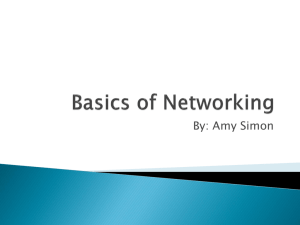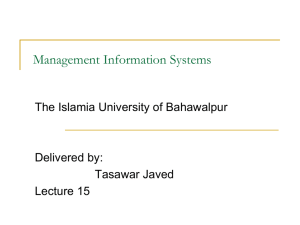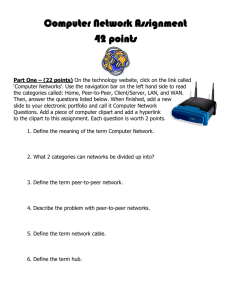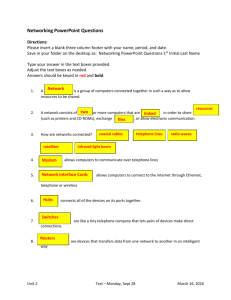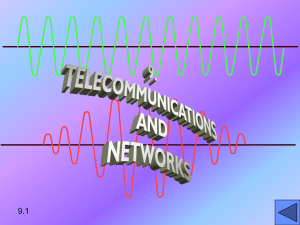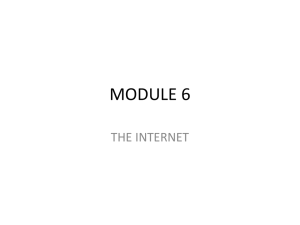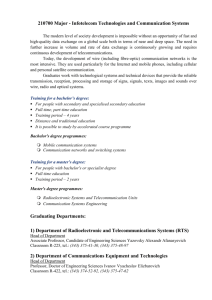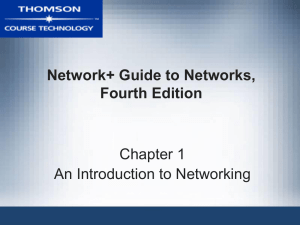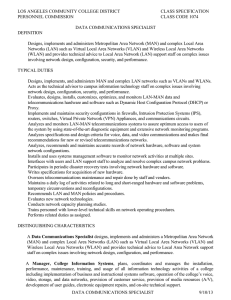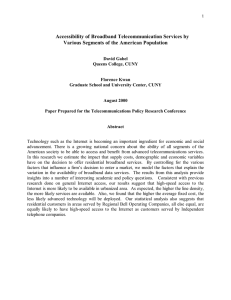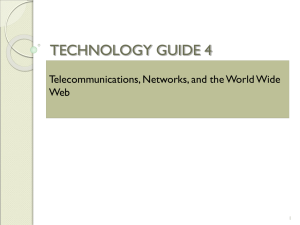Analog and Digital Signals - MIS315-05
advertisement
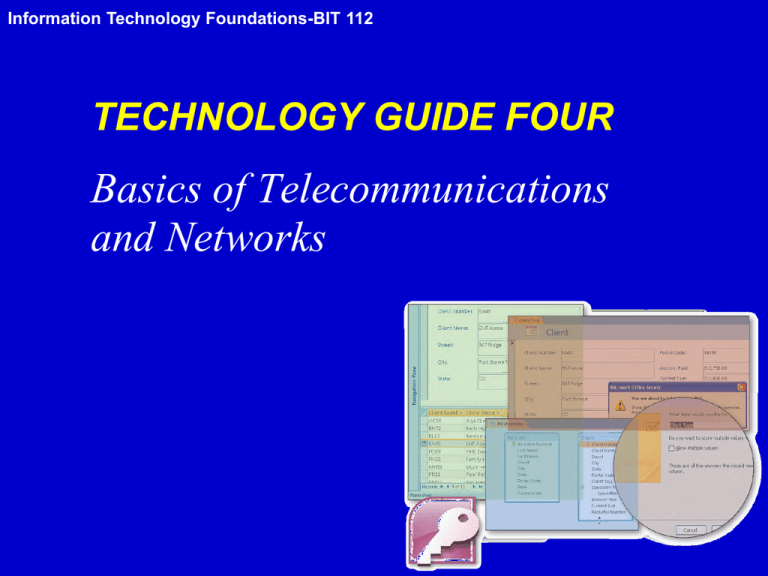
Information Technology Foundations-BIT 112 TECHNOLOGY GUIDE FOUR Basics of Telecommunications and Networks Information Technology Foundations-BIT 112 Technology Guide Outline • TG4.1 The Telecommunications System • TG4.2 Types of Networks • TG4.3 Network Fundamentals 2 Information Technology Foundations-BIT 112 Learning Objectives • Understand the basic telecommunications system. • Describe the major types of networks. • Describe the Ethernet and TCP/IP protocols. • Differentiate between client/server computing and peer-to-peer computing. 3 Information Technology Foundations-BIT 112 The Telecommunications System • A telecommunications system consists of hardware and software that transmit information from one location to another. 4 Information Technology Foundations-BIT 112 Analog and Digital Signals 5 Information Technology Foundations-BIT 112 Communications Processors • Modem: – Device that converts digital signals to analog signals and vice versa. • dial-up modem • DSL modem • Cable modem • Multiplexer: – An electronic device that allows a single communications channel to carry data transmissions simultaneously form many sources. • Front-End Processor: – A specialized computer that manages all routing communications with peripheral devices. 7 Information Technology Foundations-BIT 112 Communications Media and Channels • Twisted-pair wire – Most prevalent form of communications wiring; consists of strands of copper wire twisted in pairs. • Coaxial cable – Insulated copper wire used to carry high-speed data traffic and television signals. • Fiber optics – Thin filaments of glass fibers that transmit information via light pulses generated by lasers. 8 Information Technology Foundations-BIT 112 Twisted Pair Wire 9 Information Technology Foundations-BIT 112 Coaxial Cable 10 Information Technology Foundations-BIT 112 Fiber Optics Cable 11 Information Technology Foundations-BIT 112 Transmission Speed • Bandwidth – The range of frequencies available in any communications channel. – Narrowband • Low-speed transmission speed transmissions up to 64 Kbps. – Broadband • High-speed transmission speeds ranging from 256 to several terabits per second. 12 Information Technology Foundations-BIT 112 Transmission Technolgies • Integrated Services Digital Network (ISDN) – Data transmission technology that allows users to transfer voice, video, image, and data simultaneously over existing telephone lines. • Digital Subscriber Line (DSL) – A high-speed, digital data transmission technology using existing analog telephone lines. • Asynchronous Transfer Mode (ATM) – Data transmission technology that uses packet switching and allows for almost unlimited bandwidth on demand. • Synchronous Optical Network (SONET) – An interface standard for transporting digital signals over fiber optic lines that allows users to integrate transmissions from multiple vendors. • T-Carrier System – Digital transmission system that defines circuits that operate at different rates, all of which are multiples of the basic 64 Kbps user to transport a single voice call. 13 Information Technology Foundations-BIT 112 Types of Networks • A computer network is a system that connects computers via communications media so that data can be transmitted among them. – Local area networks (LAN) • Connects two or more devices in a limited geographical region – Wide are network (WAN) • Networks that cover large geographical areas – Value-added network (VAN) • A type of wide area network that are private, data-only networks managed by third parties that provide telecommunication and computing services to multiple organizations. – Enterprise network • The entire network of an organization, usually consisting of multiple local area networks and multiple wide area networks. 14 Information Technology Foundations-BIT 112 Local Area Network • Network Interface Card – Hardware that allows devices in a LAN to physically connect to the communication medium. • Switch – A special computer that allows devices in a LAN to communicate with each other. • File Server – A special computer that contains user software and data files for a LAN, and the network operating system. • Gateway – A communication processor that connects dissimilar networks by translating from one set of protocols to another. • Bridge – A communication processor that connects two networks of the same type. • Router – A communication processor that routes messages through several connected LANS or to a WAN. 15 Information Technology Foundations-BIT 112 Network Fundamentals • Network Protocol – A set of rules and procedures that govern transmission across a network. • Ethernet – A common LAN protocol. • Transmission Control Protocol/Internet Protocol (TCP/IP) – A file transfer protocol that can send large files of information across sometimes unreliable network with assurance that the data will arrive uncorrupted; the protocol of the Internet. • Types of Network Processing – Client/server • Links two or more computers in an arrangement in which some machines (called servers) provide computing services for user computers (called clients). – Peer-to-Peer processing • A type of client/server distributed processing where each computer acts as both a client and a server. 18 Information Technology Foundations-BIT 112 The Four Layers of the TCP/IP Protocol 19 Information Technology Foundations-BIT 112 Packet Switching 20 Information Technology Foundations-BIT 112 The Search for Extraterrestrial Intelligence: Peer-to-Peer Processing 21

